Zoom
Trash

Indigenous rights. Indigneous Victorian communities have a rich history, passed on to us through art, activism and oral history Find out about Native Title. Remembering the Freedom Ride - History (10) Transcript 00:00:00:00MICHAEL BRISSENDEN:Fifty years ago a group of university students boarded a bus and set out to expose deep seated racism in country towns across New South Wales.
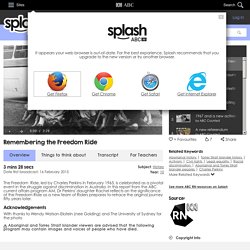
The Freedom Rides, as they became known, were lead by the late Charles Perkins. This week his daughter and some of the original Freedom Riders will join a group of students to re-enact that historic journey. AM's Lindy Kerin reports.00:00:20:01LINDY KERIN:It was 1965 and discrimination and segregation in regional New South Wales was about to hit national headlines.00:00:28:02NEWS READER:It was still very hot outside the Walgett police station as two hostile groups faced one another across the dry, dusty road. On the one side were 30 or so Aborigines and a similar number of students from Sydney University.
Indigenous rights. How Aboriginal activism brought change. IT WAS BUT HALF a century ago, a time still sharp in the minds of a baby boomer generation, that landmark battles were waged and won by Aboriginal people, for Aboriginal people.
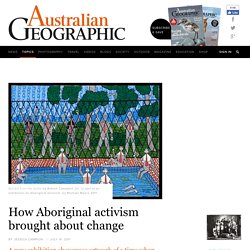
The leadership of women in the 1967 Referendum. National Sorry Day - History (10) The Freedom Ride: then and now - History (10) Transcript 00:00:00:00ELEANOR HALL:A group of high school students is retracing the 1965 Freedom Rides through New South Wales that were led by the late Aboriginal leader Charles Perkins.
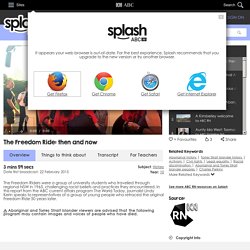
The students are halfway through the 2,300-kilometre journey that aimed to tackle racism in small country towns. But they told our reporter, Lindy Kerin, that they found racism alive and well.00:00:20:10LINDY KERIN:They left Sydney earlier this month and will visit 21 towns in regional New South Wales. It's the exact same journey taken by a group of 30 university students more than 40 years ago.
Righting wrongs in the 1967 referendum - History (10) Collaborating for Indigenous Rights 1957-1973. Student Action for Aborigines was formed at the University of Sydney in 1964 The Freedom Ride through western New South Wales towns in February 1965 drew attention to the racism in these towns.
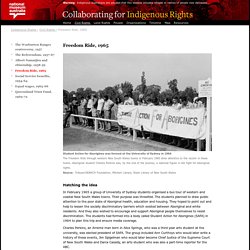
Aboriginal student Charles Perkins was, by the end of the journey, a national figure in the fight for Aboriginal rights.Source: Tribune/SEARCH Foundation, Mitchell Library, State Library of New South Wales Hatching the idea In February 1965 a group of University of Sydney students organised a bus tour of western and coastal New South Wales towns. Their purpose was threefold. The students planned to draw public attention to the poor state of Aboriginal health, education and housing. Charles Perkins, an Arrente man born in Alice Springs, who was a third year arts student at the university, was elected president of SAFA. Charles Perkins speaks to Aboriginal residents at Moree The Freedom Ride was both a fact-finding mission and a protest against racial segregation.
Aboriginal and Torres Strait Islander peoples. The Queensland Government will further address the historical issue of reparations for wages and savings stolen from Aboriginal and Torres Strait Islander Queenslanders.
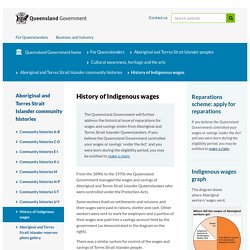
If you believe the Queensland Government controlled your wages or savings 'under the Act' and you were born during the eligibility period, you may be entitled to make a claim. ( ) From the 1890s to the 1970s the Queensland Government managed the wages and savings of Aboriginal and Torres Strait Islander Queenslanders who were controlled under the Protection Acts. Some workers lived on settlements and missions and their wages were paid in rations, shelter and cash. Collaborating for Indigenous Rights 1957-1973. University of New England students protesting over the Queensland Trust Fund Aboriginal students at the University of New England were particularly active in this campaign.Source: Barry Christophers papers, MS 7992, National Library of Australia Aboriginal Queenslanders who were 'under the Act' did not have the right to spend or manage their own money.
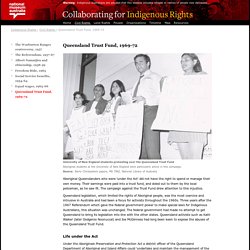
Their earnings were paid into a trust fund, and doled out to them by the local policeman, as he saw fit. The campaign against the Trust Fund drew attention to this injustice. Queensland legislation, which limited the rights of Aboriginal people, was the most coercive and intrusive in Australia and had been a focus for activists throughout the 1960s. Three years after the 1967 Referendum which gave the federal government power to make special laws for Indigenous Australians, this situation was unchanged.
Collaborating for Indigenous Rights 1957-1973. For white civil rights activists in the 1960s, equal pay was the basic marker of acceptance and social inclusion in Australian society.
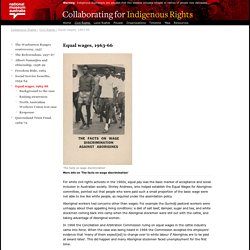
Shirley Andrews, who helped establish the Equal Wages for Aborigines committee, pointed out that people who were paid such a small proportion of the basic wage were not able to live like white people, as required under the assimilation policy. Aboriginal workers had concerns other than wages. Collaborating for Indigenous Rights 1957-1973. Joyce Maher (Tapakari), with Bernadette and Roderick, 1960 'A station hand's wife and young family: Tapakari (Joyce Maher) with Bernadette (1½ years) and Roderick (3 mths).
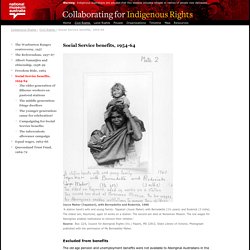
The eldest son, Raymond, aged 14 works on a station. The second son died at Norseman Mission. The low wages for Aborigines enables institutions to remove their children.'Source: Box 12/6, Council for Aboriginal Rights (Vic.) Papers, MS 12913, State Library of Victoria. Excluded from benefits. The-50th-Anniversary-of-the-1965-Freedom-Ride1. Collaborating for Indigenous Rights 1957-1973. Collaborating for Indigenous Rights 1957-1973. Albert Namatjira signing autographs, early 1950s Albert Namatjira was publicly regarded as an example of an Aboriginal person who had succeeded in white society.Source: National Library of Australia Famous artist not legally Aboriginal In the late 1950s almost all Aboriginal people of full descent in the Northern Territory were wards of the state.
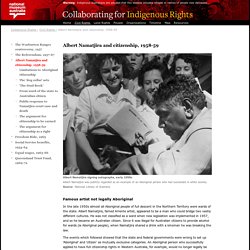
Albert Namatjira, famed Arrente artist, appeared to be a man who could bridge two vastly different cultures. The 1967 referendum. On 27 May 1967, Australians voted in favour of changes to the Australian Constitution to improve the services available to Indigenous Australians.
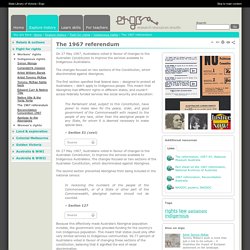
The changes focused on two sections of the Constitution, which discriminated against Aborigines. The first section specified that federal laws – designed to protect all Australians – didn't apply to Indigenous people. This meant that Aborigines had different rights in different states, and couldn't access federally funded services like social security and education: Collaborating for Indigenous Rights 1957-1973. Aunt Celia and Granny Monsell campaigning in Brisbane for a YES vote Brisbane campaign for a YES vote on the referendum Aboriginal issue, 1967.Source: Bond collection, Australian Institute of Aboriginal and Torres Strait Islander Studies, Canberra Changing the Australian Constitution In 1967, after ten years of campaigning, a referendum was held to change the Australian Constitution.
Two negative references to Aboriginal Australians were removed, giving the Commonwealth the power to legislate for them as a group. This change was seen by many as a recognition of Aboriginal people as full Australian citizens. The referendum campaign effectively focused public attention on the fact that Aboriginal and Torres Strait Islander Australians were second class citizens with all sorts of limitations - legislative and social - on their lives. Australian Institute of Aboriginal and Torres Strait Islander Studies. Collaborating for Indigenous Rights 1957-1973. Aboriginal delegates Jeff Barnes, Doug Nicholls and Bert Groves, Adelaide, February 1958 Twenty-six people attended this meeting, which formed the Federal Council for Aboriginal Advancement, including the three Aboriginal delegates and Bill Onus, an Aboriginal observer, representing the Australian Aborigines' League.Source: The Advertiser, Adelaide, 17 February 1958 When forty or more Aboriginal nomads were found sick and malnourished in the Central Desert in 1956 questions were raised in the Western Australian parliament.
As a part of its nuclear testing partnership with the British government, the Commonwealth government had established a weather station and was testing nuclear weapons and firing rockets over the desert. Australian Institute of Aboriginal and Torres Strait Islander Studies. The students that made up SAFA came from many different existing societies including the Australian Labor Party (ALP), the Newman society, the Jewish Students Union and the Civil Liberties Association. Led by Charles Perkins there were around 35 students that took part in the Freedom Ride. Note: Ages are sometimes approximate, and both age and enrolment in university courses are for February 1965. Charles Perkins 29, third year Arts, Arrernte man, born in Alice Springs, former soccer player, Aboriginal activist, President of SAFA.